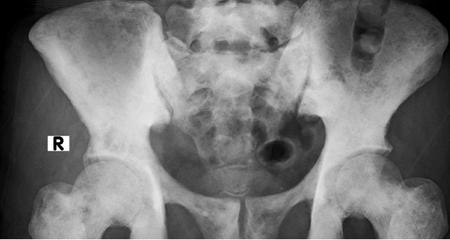If cancer has spread to the bone or soft tissue (muscle, tendons, nerves, blood vessels) from another location in the body, it is considered metastatic bone disease (metastatic bone cancer or bone mets). More than half of all cancer patients will develop bone metastases. To address this challenging problem, we created the Bone Metastasis Program — a team of physicians and clinicians who specialize in treating patients with metastatic bone disease.
The most common cancers that may spread to the bone are:
- Breast cancer
- Lung cancer
- Prostate cancer
- Kidney cancer
- Thyroid cancer
Metastatic bone disease can weaken and damage the bone, making patients prone to fractures. Metastatic bone disease often affects the spine, skull, ribs, pelvis, arms and legs.
Preventing Bone Metastases
As part of your cancer treatment, your team may be able to take steps to lessen the chances that the cancer will spread to your bones. Chemotherapy and targeted therapy can control how cancer cells grow and spread. Radiation therapy can also prevent cancer from spreading to the bones.
Metastatic Bone Cancer Symptoms
You have the best chance of surviving if bone metastases are found and treated early. By the time bone metastases are diagnosed, however, there is usually a fractured bone. If you have cancer, these could be the first signs that you have metastatic bone cancer.
- Dull ache that doesn’t go away and gets worse with time
- Pain that happens when bearing weight on a specific limb
- Pain at night with or without night sweats
- Pain when you touch a specific area
- Unexplained pain in a specific area for people older than age 45
- Pain that gets much worse suddenly, especially if you have not had a traumatic injury like falling down
- Unexplained weight loss with pain
- Back pain
If you experience these symptoms, tell your primary cancer care team. Your doctors may consult with or refer you to our Bone Metastasis Program.
Hypercalcemia
Besides pain, people with bone metastases can have symptoms of hypercalcemia — an abnormally high level of calcium in the blood. Be sure to alert your primary cancer care team if you suffer from any of these hypercalcemia symptoms:
- Nausea
- Vomiting
- Polyuria (making large amounts of urine)
- Muscle weakness
- Constipation
- Confusion and other neurologic symptoms
Diagnosis
The first step is accurate diagnosis with imaging such as — X-rays, CT scans or MRI — to find out how far the disease has spread. You'll also need a bone biopsy. Figuring out how long a person will live and predicting how they will respond to treatment helps the team provide the best options. For instance, if a person is expected to live longer than six months, we may recommend surgery to fix fractures and make sure the bone is stable.
If your primary cancer hasn’t yet been diagnosed, we will work to determine it through imaging, biopsy and other diagnostic tools. Until proven otherwise, bone tumors are treated as primary cancers (sarcomas, or cancers that started in the bone). That way, we make sure there is no delay in cancer treatment. As soon as we determine the primary cancer, we adjust therapies accordingly.
Patients with metastatic bone disease need comprehensive, well-coordinated care from a variety of disciplines. As a part of a multidisciplinary team, we work closely with experts from every cancer specialty to deliver the best patient care and advanced treatment options for each individual patient.
We aim to keep you on your feet and keep the affected bone(s) as healthy as possible while you are being treated for your primary cancer.
Metastatic Bone Cancer Treatment
Our treatment goals are to:
- Control pain.
- Keep your quality of life the same or make it better.
- Allow you to put weight on your legs or arms right away.
- Stop the disease from getting worse, if possible.
Additionally, we do whatever we can to prevent fractures. A fracture can be very complicated and limit the types of treatment you can have.
Treating Small Bone Tumors
Bone tumors that are small and painless and have a low risk of causing fractures can be treated to keep the disease from getting worse and to prevent fractures. Treatments may include:
- Radiation therapy alone
- Systemic treatments
- Hormonal therapy
- Immunotherapy or targeted therapies
- Chemotherapy
- Medications to strengthen bones
Systemic treatments may be combined with radiation therapy to keep the small tumors from growing and spreading.
Percutaneous Ablation
If the small tumors are painful and in areas that are hard to reach with surgery, we can perform percutaneous ablation. The procedure involves placing a needle through the skin into the tumors and destroying them with heat. We use a CT scan to make sure the needle is put in the right place.
Treating Large Bone Tumors
Bone tumors that are large and cause pain and other symptoms are treated to control the disease, keep the ability to walk and move and relieve pain. We can treat these large tumors with:
- Orthopaedic surgery that is right for the disease stage, your medical condition and your preferences to help with:
- Support
- Stabilization
- Limb reconstruction
- Fracture repair
- Radiation therapy
- Systemic therapies
- Chemotherapy
- Hormonal therapy
- Targeted therapies
- Immunotherapy
NIMBLE App Provides a Faster Path to Treating Bone Metastases
Treatment for cancer that is spreading can't wait, so experts in our Metastatic Bone Disease Program mapped out all of the different types of primary cancer that can metastasize to the bones. This mapping included all of the variables — tumor pathology, number of tumors, tumor location, tumor size and the patient's general health. Based on the mapping, our specialists developed treatment protocols that adjust for all of the different variables that go into treating metastatic bone cancer.
Originally developed for metastatic brain tumors, we modified our NIMBLE app to include the metastatic bone disease variables. NIMBLE stands for Network for the Integrated Management of Brain (and Bone) Metastasis Linking Experts. It is a tool for physicians to make referrals, consult and collaborate with our bone metastasis specialists. Using the protocols outlined in the app, our team can provide treatment recommendations in a matter of hours, instead of days or weeks.
Dedicated Froedtert & MCW Bone Metastasis Treatment Team
A team approach to treating cancer that has spread to the bones is important for planning your best treatment. The team should include:
- Medical oncologists
- Radiation oncologists
- Radiologists who specialize in cancer imaging
- Pathologists
- Orthopaedic surgeons (with a focus on bone metastasis)
- Anesthesiologists
- Palliative care specialists
- Rehabilitation experts — physical therapists, occupational therapists and more
Our team includes experts in all of these roles who will work with your primary cancer team to make sure your get the best outcome possible.
Our Team
Virtual Visits Are Available
Safe and convenient virtual visits by video let you get the care you need via a mobile device, tablet or computer wherever you are. We’ll gather your medical records for you and get our experts’ input so we can offer treatment options without an in-person visit. To schedule a virtual visit, call 1-866-680-0505.
More to Explore












